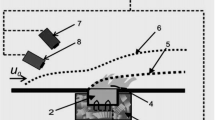Abstract
Hydrogen-air mixtures are highly flammable. The acceleration of the flame and subsequent deflagration to detonation transition (DDT) can cause enormous damage to hydrogen energy infrastructure. Since leakage of hydrogen and its subsequent stratification according to the height of a room or structure is the most likely process to cause emergencies that arise at hydrogen energy facilities, studies of combustion and detonation in stratified hydrogen-air mixtures are of particular interest. The paper presents the results of the estimated flame front velocity and maximum overpressure in experiments involving the deflagration of a hydrogen-air mixture for vertical gradients of the hydrogen volume fraction in a closed channel with an annular blockage. This horizontally oriented channel has a square section of 0.6 × 0.6 m and a length of 12 m. The average hydrogen content of the gas used in the experiments varied in the range of 9–15 vol %.





Similar content being viewed by others
References
Vollmer, K., Ettner, F., Sattelmayer, T.: Deflagration-to-detonation transition in hydrogen/air mixtures with a concentration gradient. Combustion Sci Techn 184(10–11), 1903–1915 (2012)
Kirillov, I.A., Kharitonova, N.L., Sharafutdinov, R.B., Khrennikov, N.N.: Ensuring hydrogen safety at nuclear power plants with water-cooled reactors. Current status of the problem. Yadernaya I Radiatsionnaya Bezopasnost 2(84), 26–37 (2017)
Ciccarelli, G., Dorofeev, S.: Flame acceleration and transition to detonation in ducts. Prog Energy Combust Sci 34, 499–550 (2008)
Vollmer, K., Ettner, F., Sattelmayer, T.: Influence of concentration gradients on flame acceleration in tubes. Sci Techn Energ Mater J Japan Explos Soc 72, 74–77 (2011)
Gel’fand, B.E., Sil’nikov, M.V., Medvedev, S.P., Khomik, S.V.: Thermal dynamics of hydrogen combustion and explosion. Izd-vo Politekhn. un-ta, Saint Petersburg (2009)
Scarpa, R., Studer, E., Kudriakov, S.: Influence of initial pressure on hydrogen/air flame acceleration during severe accident in NPP. Intern Hydrog Energy 44, 9009–9017 (2019)
Wang, L., Ma, H., Shen, Z.: Experimental study of detonation propagation in a square tube filled with orifice plates. Intern Hydrog Energy 3(9), 4645–4656 (2019)
Bentaib, A., Bleyer, A., Meynet, N.: SARNET hydrogen deflagration benchmarks. Main outcomes and conclusions. Ann Nucl Energy 74, 143–152 (2014)
Boeck, L.: Deflagration-to-detonation transition and detonation propagation in H2–air mixtures with transverse concentration gradients. Techn. Universität München Institut für Energietechnik (2015)
Kuznetsov, M., Alekseev, V., Dorofeev, S.: Detonation propagation, decay, and reinitiation in nonuniform gaseous mixtures. Symp Combust 27, 2241–2247 (1998)
Rudy, W., Kuznetsov, M., Porowski, R.: Critical conditions of hydrogen-air detonation in partially confined geometry. Proc Combust Inst 32(2), 1965–1972 (2012)
Grune, J., Sempert, K., Friedrich, A.: Detonation wave propagation in semi-confined layers of hydrogeneair and hydrogeneoxygen mixtures. Intern Hydrog Energy 23(11), 7589–7599 (2016)
Friedrich, A., Grune, J., Sempert, K.: Hydrogen combustion experiments in a vertical semi-confined channel. Intern Hydrog Energy 44(17), 9041–9049 (2018)
Kuznetsov, M., Yanez, J., Grune, J.: Hydrogen combustion in a flat semi-confined layer with respect to the Fukushima Daiichi accident. Nucl Engng Des 286, 36–48 (2015)
Peraldi, O., Knystautus, R., Lee, J.: Criteria for transition to detonation in tubes. 21 Combust. Symp. Intern. , 1629–1637 (1986)
Author information
Authors and Affiliations
Corresponding author
Additional information
Translated from Atomnaya Energiya, Vol. 134, No. 5–6, pp. 278–282, May–June, 2023.
Publisher’s Note
Springer Nature remains neutral with regard to jurisdictional claims in published maps and institutional affiliations.
Original article submitted June 30, 2023.
Rights and permissions
Springer Nature or its licensor (e.g. a society or other partner) holds exclusive rights to this article under a publishing agreement with the author(s) or other rightsholder(s); author self-archiving of the accepted manuscript version of this article is solely governed by the terms of such publishing agreement and applicable law.
About this article
Cite this article
Yakovlev, S.A., Bezgodov, E.V., Stakhanov, V.V. et al. Experimental studies of combustion processes of stratified and uniform hydrogen-air mixtures. At Energy (2024). https://doi.org/10.1007/s10512-024-01069-9
Published:
DOI: https://doi.org/10.1007/s10512-024-01069-9




